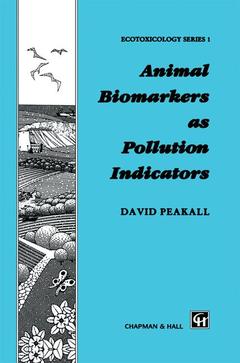Animal Biomarkers as Pollution Indicators, Softcover reprint of the original 1st ed. 1992 Chapman & Hall Ecotoxicology Series
Langue : Anglais
Coordonnateur : Peakall David B.

Ecotoxicology is a relatively new scientific discipline. Indeed, it might be argued that it is only during the last 5-10 years that it has come to merit being regarded as a true science, rather than a collection of procedures for protecting the environment through management and monitoring of pollutant discharges into the environment. The term 'ecotoxicology' was first coined in the late sixties by Prof. Truhaut, a toxicologist who had the vision to recognize the importance of investigating the fate and effects of chemicals in ecosystems. At that time, ecotoxicology was considered a sub-discipline of medical toxicology. Subsequently, several attempts have been made to portray ecotoxicology in a more realistic light. Notably, both F. Moriarty (1988) and F. Ramade (1987) emphasized in their books the broad basis of ecotoxicology, encompassing chemical and radiation effects on all components of ecosystems. In doing so, they and others have shifted concern from direct chemical toxicity to man, to the far more subtle effects that pollutant chemicals exert on natural biota. Such effects potentially threaten the existence of all life on Earth. Although I have identified the sixties as the era when ecotoxicology was first conceived as a coherent subject area, it is important to acknowledge that studies that would now be regarded as ecotoxicological are much older. Wherever people's ingenuity has led them to change the face of nature significantly, it has not escaped them that a number of biological con sequences, often unfavourable, ensue.
1 Scope and limitations of classical hazard assessment.- 1.1 The exposure side of the equation.- 1.2 The toxicity side of the equation.- 1.3 Hazard assessment.- 2 Biomarkers of the nervous system.- 2.1 Esterase inhibition.- 2.2 Biogenic amines.- 3 Biomarkers of the reproductive system.- 3.1 Studies of the breeding cycle.- 3.2 Studies on embryos.- 3.3 Hormones.- 4 Studies on genetic material.- 4.1 Introduction.- 4.2 RNA/DNA ratio.- 4.3 DNA adducts.- 4.4 DNA strand breakage.- 4.5 Degree of methylation of DNA.- 4.6 Sister chromatid exchange.- 4.7 Use of genetic material in monitoring.- 5 Mixed function oxidases.- 5.1 Introduction.- 5.2 Nomenclature.- 5.3 General description of the system.- 5.4 Factors influencing activity.- 5.5 Interactions with other biomarkers.- 5.6 Mechanism of action, receptors and dioxin equivalents.- 5.7 Use of mixed function oxidases as biomarkers.- 6 Thyroid function, retinols, haem and regulatory enzymes.- 6.1 Thyroid function.- 6.2 Vitamin A (retinoids).- 6.3 Haem, porphyrins and inhibition of aminolevulinic acid dehydratase (ALAD) by lead.- 6.4 Enzyme activity.- 7 Behavioural effects: their relationship to physiological changes.- 7.1 Introduction.- 7.2 Types of tests used.- 7.3 Behavioural effects of polyhalogenated aromatic hydrocarbons.- 7.4 Behavioural effects of organophosphates.- 7.5 Behavioural effects of heavy metals and other pollutants.- 7.6 Relationship of behavioural effects to biomarkers.- 8 Environmental immunotoxicology.- 8.1 Introduction.- 8.2 The immune system as a target for xenobiotic interaction.- 8.3 Relationship of immunotoxicology and other toxic effects.- 8.4 Immunotoxic chemicals.- 8.5 Assessment and prediction of immunotoxicity.- 8.6 Application of immunoassays in environmental studies.- 8.7 Conclusions.- 9 The use of animals in wildlife toxicology.- 9.1 Introduction.- 9.2 The LD50 and related tests.- 9.3 Comparison of measurements in blood to organs.- 9.4 The role of tissue culture experiments.- 9.5 Statistical considerations.- 10 The role of biomarkers in environmental assessment.- 10.1 Biomarkers and the epidemiological approach.- 10.2 Current status of monitoring based on biomarkers.- 10.3 Relationship between chemical exposure and biomarker response.- 10.4 Relationship between responses of biomarkers to adverse effects.- 10.5 Strategy for using biomarkers.- Appendix 1 Latin names of species referred to in text.- Appendix 2 Abbreviations.- References.
Date de parution : 11-2012
Ouvrage de 291 p.
15.5x23.5 cm
Thèmes d’Animal Biomarkers as Pollution Indicators :
© 2024 LAVOISIER S.A.S.



